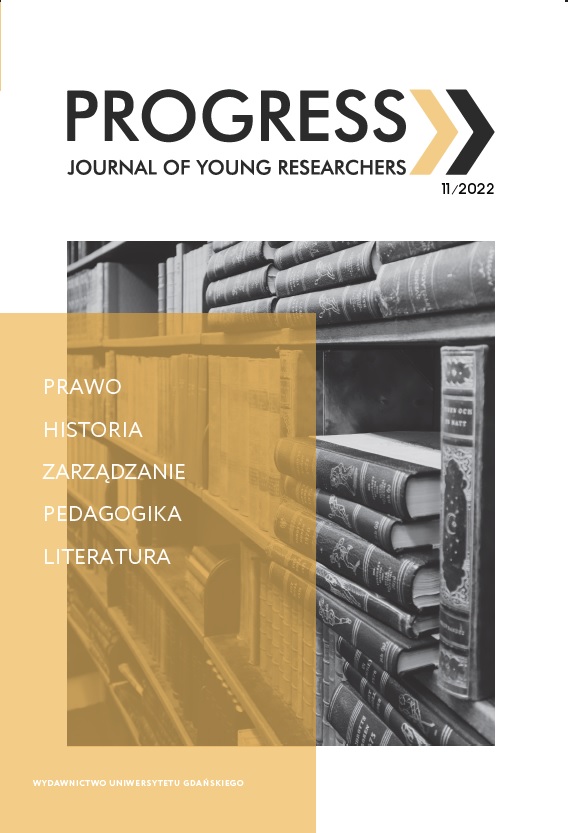Tendency of households from the lubelskie voivodeship to save and invest
DOI:
https://doi.org/10.26881/prog.2022.11.12Keywords:
savings, investments, households, financial resources, savings and investments in the Lubelskie VoivodeshipAbstract
The main purpose of the article was to analyze the inclination of representatives of Lublin households to save and invest. The studies have been carried out in Lublin Voivodeship which has the lowest GDP per capita and is classified as one of the regions facing the highest poverty risk. The article consists of a theoretical part introducing the basics of saving and investing processes and an empirical part presenting results of the research conducted by the author between March and May of 2020 with the use of diagnostic survey method. Five hundred adults from Lublin Voivodeship were subject to the studies. The results indicate that saving is important for the surveyed households members securing their own and their housemates future. In the absence of money, households take out bank loans. Investments, in turn, are a high-risk process. The level of risk itself may be higher the higher the level of information asymmetry and other limitations of the investor’s access to information limiting the investment risk assessment. In the opinion of the respondents, the level of their economic knowledge about saving and investing is moderate.
Downloads
References
Analizy.pl, 2020, https://www.analizy.pl/raporty/25670/struktura-oszczednosci-gospodarstw-domowych-marzec-2020 (dostęp: 6.05.2021).
BIG Infomonitor, 2020, https://media.big.pl/informacje-prasowe/568142/program-500-rodzice-za-bezdzietni-przeciw (dostęp: 6.05.2021).
Bywalec C., 2012, Ekonomika i finanse gospodarstw domowych, Warszawa.
Finanse Polaków w czasie COVID-19, 2020, https://zpp.net.pl/wp-content/uploads/2020/11/Raport-Finanse-Polak%C3%B3w-w-czasie-COVID-19.pdf (dostęp: 22.01.2021).
Frączak B., 2012, Analiza czynników wpływających na oszczędzanie i inwestowanie gospodarstw domowych, Katowice.
GUS, 2020, https://stat.gov.pl/obszary-tematyczne/rachunki-narodowe/rachunki-regionalne/wstepne-szacunki-produktu-krajowego-brutto-w-przekroju-regionow-w-2019-roku,8,3.html (dostęp: 7.05.2021).
Hadaś-Dyduch M., 2016, Klasyfikacja lokat inwestycyjnych i bankowych papierów wartościowych w klasy rozkładu zwrotu, nr 301, Studia Ekonomiczne Uniwersytetu Ekonomicznego w Katowicach., Katowice.
Halicki M., 2015, Inwestycje – charakterystyka pojęcia i podstawy rachunku inwestycyjnego, „Przegląd Geopolityczny”, t. 12.
http://regiodom.pl/portal/wiadomosci/analizy-raporty/ceny-mieszkan-z-rynku-wtornego-lekko-w-dol-ile-kosztuja-uzywane-mieszkani (dostęp: 20.01.2021).
Keynes J.M., 2003, Ogólna teoria zatrudnienia, procesu i pieniądza, Warszawa.
Krupa D., Walczak D., Chojnacka E., 2012, Preferencje w zakresie form alokacji oszczędności gospodarstw domowych w Polsce, „Copernican Journal of Finance & Accounting”, Vol. 1, No. 1.
Liberda B., 2013, Przezorność. Kto oszczędza w Polsce, Warszawa.
Łabenda K.P., 2011, Budżet domowy pod kontrolą, Gliwice.
Markowski K., 2000, Uwarunkowania decyzji inwestycyjnych gospodarstw domowych, Szczecin. Mayo H.B., 2017, Investments: An Introduction, Cengage.
Ministerstwo Finansów, 2021, https://www.gov.pl/web/finanse/wyniki-sprzedazy-obligacji-oszczednosciowych-w-grudniu-2020-roku (dostęp: 6.05.2021).
Nwibo S.U., Mbam B.N., 2013, Determinants of Savings and Investment Capacities of Farming Households in Udi Local Government Area of Enugu State, „Research Journal of Finance and Accounting”, Vol. 4.
Piekut M., 2013, Konsumpcja w polskich gospodarstwach domowych na tle krajów europejskich, „Problemy Zarządzania”, t. 11, nr 1(40).
Santander Bank S.A., 2020, Finansowe DNA Polek i Polaków. Oszczędzanie i inwestowanie, Warszawa, https://secure.sitebees.com/file/mediakit/1785421/c1/finansowe_dna_polek_i_polako_w_2020.pdf (dostęp: 9.07.2021).
Reilly F.K., Brown K.C., 2001, Analiza inwestycji i zarządzania portfelem, Warszawa.
Rudnicki L., 2013, Zarządzanie finansami w gospodarstwach domowych, Tarnów.
Szulce H., Chwałek J., Ciechomski J., 2008, Ekonomika handlu, cz. 1, Warszawa.
Downloads
Published
How to Cite
Issue
Section
License
Copyright (c) 2022 Author(s)

This work is licensed under a Creative Commons Attribution 4.0 International License.

 Academic Scientific Journals
Academic Scientific Journals




